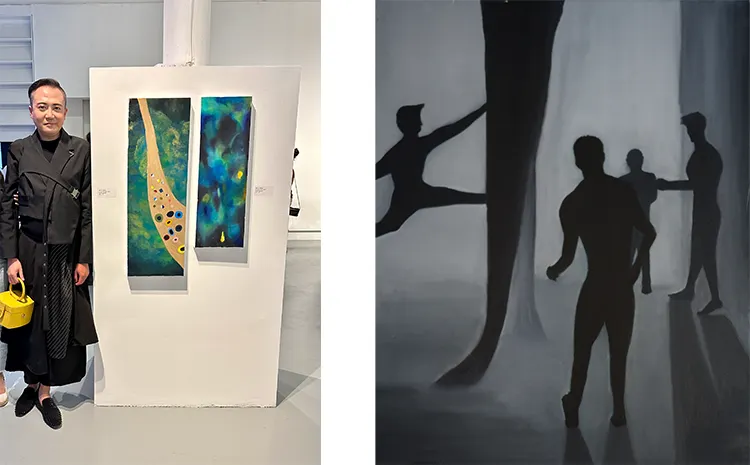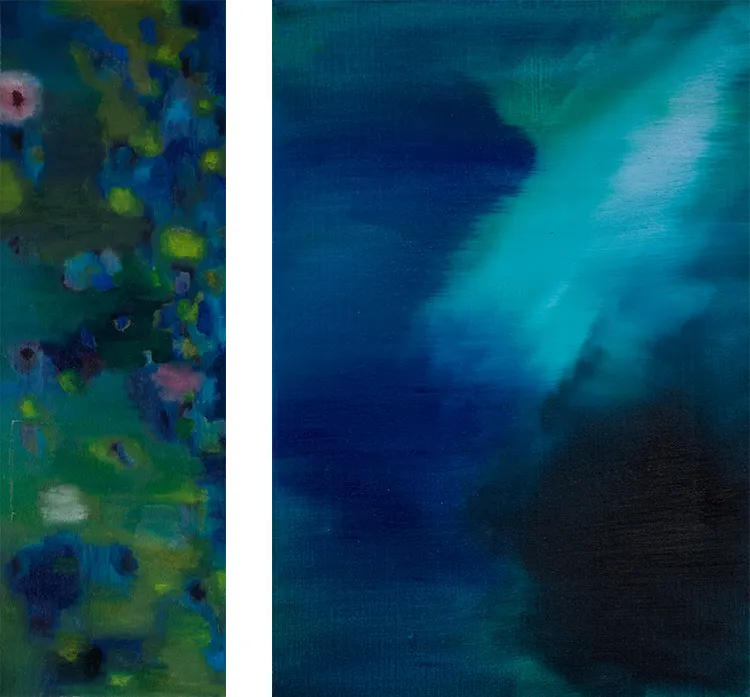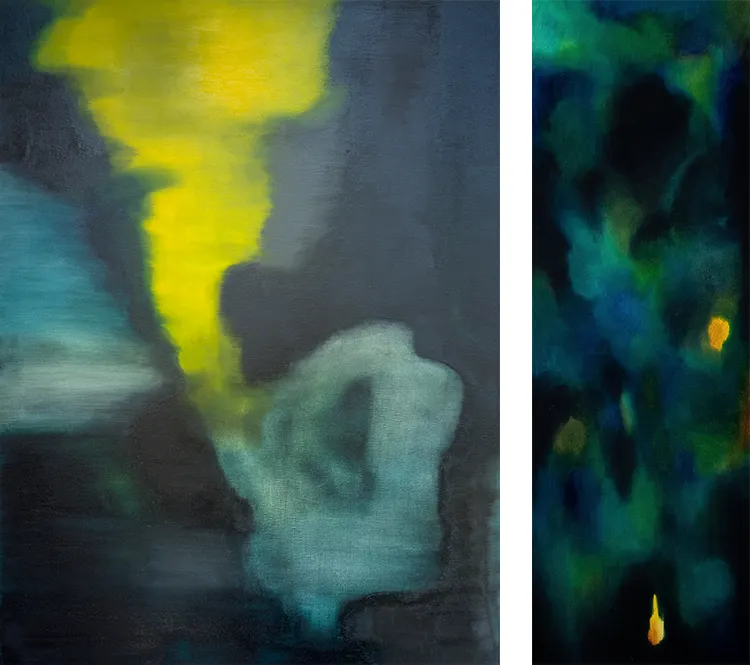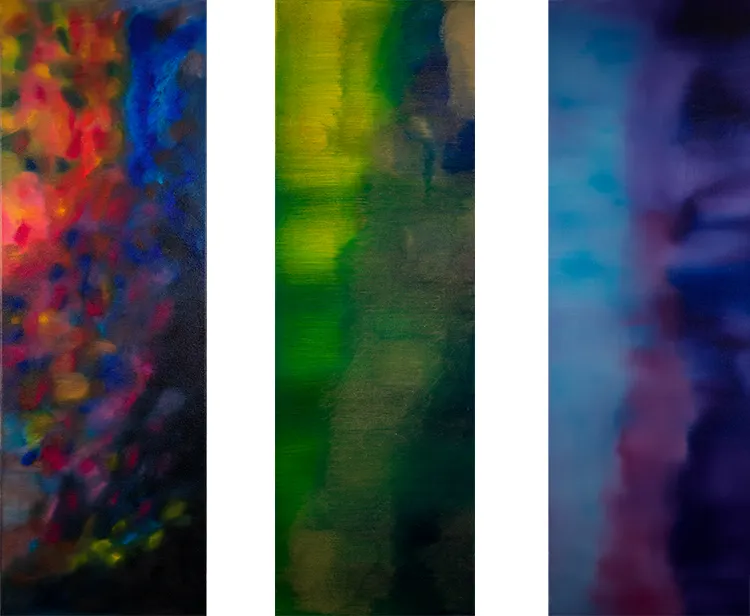“I see movement as an emotional language, and my paintings reflect that—blurring the lines between the seen and the felt, the tangible and the ephemeral.”
A Journey from Strategy to Abstraction
Alex Z. Wang’s path to becoming a painter was anything but conventional. Before fully immersing himself in the world of art, he spent over a decade working in strategy consulting and marketing. This analytical background sharpened his ability to translate complex ideas into visual compositions, a skill that now defines his approach to abstraction. Based in New York, Wang has established himself as an artist who explores movement, depth, and atmospheric transitions, crafting works that blur the line between the tangible and the ephemeral.
His artistic practice is deeply influenced by dance, cinema, and performance, disciplines that emphasize motion as an expressive language. Wang sees movement not just as a physical act but as an emotional force, capable of capturing fleeting moments and translating them into lasting impressions. This perspective informs the way he builds his paintings—layering color, form, and texture to create dynamic compositions that seem to breathe and shift. Rather than depicting fixed subjects, he creates immersive spaces where motion and memory intertwine, inviting viewers to experience the artwork as both a visual and emotional landscape.
Though his formal artistic journey began early—training at the Luxun Academy of Arts in China from the age of six—his return to painting was a process of rediscovery. After moving to the U.S. more than a decade ago, he rekindled his practice while still working in consulting, studying at institutions like the Art Students League, Parsons, and Cooper Union. Over time, it became clear that painting was not just a passion but a calling. This realization led him to leave his corporate career behind and fully commit to his artistic practice, a decision that has since defined his life’s work.

Alex Z. Wang: Painting the Essence of Change
At the core of Wang’s artistic style is an exploration of impermanence. His paintings, rooted in abstract expressionism, convey a sense of motion and transformation, often resembling shifting light, water currents, or dissolving landscapes. Rather than capturing static moments, his work seeks to embody transition itself—the in-between states where memories form and dissolve. These dreamlike compositions invite viewers into an introspective space, evoking emotions that fluctuate between serenity and intensity.
One of the key tensions in Wang’s work lies between structure and dissolution. His paintings balance deliberate composition with organic unpredictability, reflecting the fluid nature of existence. Whether through soft, atmospheric washes or bold, gestural strokes, he constructs layered surfaces that seem to hover between presence and disappearance. This approach mirrors the way emotions, memories, and experiences constantly shift, reinforcing his fascination with the ephemeral.
A defining piece in Wang’s portfolio is Guiding Light, a painting that marked a pivotal moment in his artistic process. Unlike previous works where he sought control over every element, this piece was created through an intuitive approach, allowing forms and colors to emerge organically. The result was a work that captured depth, translucency, and movement, embodying the push and pull of memory and water. This painting stands as a testament to his philosophy—trusting the creative process, letting go of rigid expectations, and allowing the work itself to take shape naturally.

The Studio as a Space for Flow and Experimentation
Wang’s creative process unfolds across two distinct studio spaces: one in Bushwick, dedicated to oil painting, and another at home, where he explores works on paper, alcohol inks, and photography. Each environment serves a different function, but both share a common goal—providing an immersive setting where he can fully engage with his materials and ideas. Whether working with the rich textures of oil paint or the fluid unpredictability of alcohol ink, his studios act as laboratories for experimentation.
Atmosphere is essential to his practice. He carefully curates his workspace to align with his creative flow, adjusting elements like lighting and sound to suit the mood of his work sessions. Sometimes, he paints in complete silence, allowing his thoughts to guide the brushstrokes, while other times, music—whether rhythmic or cinematic—helps set the tone. Movement also plays a key role in his process; stepping away from the canvas to walk, stretch, or watch dance performances allows him to reset his perspective and return with renewed energy.
Despite the inevitability of distractions, Wang approaches them with a balance of discipline and flexibility. He structures his work periods to maintain focus while also embracing moments of spontaneity that often lead to unexpected breakthroughs. His process is as much about control as it is about surrender—an ongoing dialogue between intention and intuition. Whether refining a composition or allowing chance to shape the final outcome, his practice remains fluid, mirroring the themes of transition and impermanence that define his work.

Alex Z. Wang: Expanding the Boundaries of Abstraction
Wang’s inspirations span across both the visual and performing arts, drawing from a wide range of influences that inform his approach to abstraction. Painters like Sonia and Robert Delaunay inspire him with their dynamic use of color and rhythm, while Mark Rothko’s ability to evoke deep emotion through tonal shifts resonates deeply with his practice. He also admires Ross Bleckner’s exploration of memory and impermanence, Gerhard Richter’s controlled chaos, and J.M.W. Turner’s luminous, dissolving landscapes—all of which share a connection to Wang’s fascination with atmosphere and transformation.
Beyond painting, dance remains a profound source of inspiration. Choreographers like Martha Graham and Paul Taylor have shaped his understanding of rhythm, structure, and improvisation—principles that translate directly into his approach to painting. Just as movement in dance conveys meaning through gesture and flow, his brushstrokes and layered textures seek to capture that same expressive quality on canvas. This cross-disciplinary influence fuels his desire to push the boundaries of his work beyond traditional formats.
Looking ahead, Wang envisions creating large-scale, immersive installations that merge painting with light, sound, and movement. Rather than existing as static objects, these environments would evolve over time, engaging viewers in a sensory experience where abstraction becomes something lived rather than merely observed. Additionally, he continues to develop a series of abstract photography works, further expanding his exploration of fluidity and impermanence across different mediums. For Wang, art is not just about creating images—it is about constructing experiences that invite contemplation, transformation, and connection.








